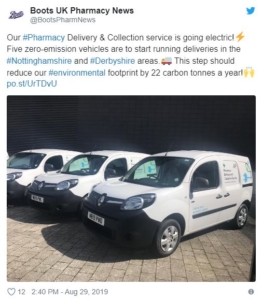Why Company Cars will be the EV’s Saviour… and its Biggest Problem
What’s interesting about the UK car market isn’t its size (31 million cars), it’s how these cars get there in the first place and crucially how that will affect the broader adoption of EVs.
Over 2 million new cars were sold last year, of which 57% were bought as company cars. These are sold on quite quickly, meaning companies buy most of the 31 million cars that most people end up owning. In other words, Fleet Directors decide the composition of the UK fleet. And most large fleet directors have said they will move to EVs as soon as there is a suitable model available.
Why do Fleet Directors want EVs?
Corporates are different from consumers. Corporates look at non-car factors such as carbon reduction goals and corporate branding when making purchasing decisions– think how odd it will be for an electricity company to choose not to use electricity to power its cars. They also look carefully at Total Cost of Ownership and already EVs are far ahead of their fossil-fuelled counterparts. All of these factors drive a much higher appetite for electric cars in the corporate sector than in the private sector. We’ve seen this first hand. In our consultancy business, we do not have a single customer who does not have an EV plan in place.
So, all’s good then? Manufacturers will shortly come to market with some viable fleet models, these will be snapped up at volume and the UK fleet will migrate to EVs at a great pace.
Not quite.
Company cars have one inherent difference; they cover high mileages, annually averaging 18,000 miles per year against the UK personal average of 5,104. High mileage means high charging.
The Rising Tide
Consumer EV adoption has been similar, in many ways, to a rising tide. There has been a gentle increase across all types of EVs and geographical areas. DNOs (Electricity distribution companies) have been able to keep ahead of this demand increase by making gentle improvements across all areas. This follows the theory of Diversified Demand, where different people demand power at different times. Charging patterns are the same.
Apologies for all the maths, but we need to chew through this.
An average annual mileage of 5,104 means about 98 miles per week which would require around 28kWh of charging. Off-peak home charging provides around 50kWh per night (7hrs at 7.2kWh) or 350kWh per week. So an electricity company only needs to find 28kWh in the window of 350kWh to charge the average car. This enables the electricity company to spread and diversify the needs of one driver across many others. The Rising Tide.
The Crashing Wave
Company drivers are different though: they are time-constrained, they return home with a low “tank” and need it full the next day. Using the same sums as before, 18,000 annual miles means 346 miles per week and a weekly charge of 100kWh. By definition, this mileage and charging will need to happen during the working week, so we are looking at finding 20kWh per night in a charging window of 50kWh. This is much harder to spread, especially when we try to ask a company car driver to sacrifice charging for the common good.
What makes this worse is that large corporates move in big steps, buying individual models of cars in their thousands. So we go from very few difficult balancers to hundreds and thousands in the time it takes to drive the new EV from the depot. Finally, company cars are not equally geographically spread, they are localised. Recruitment profiles will tend to mean that company car drivers often live quite closely together.
The end result will be very fast build-ups of un-diversified demand in concentrated areas. A Crashing Wave.
Is It All Bad News?
Not at all if the right planning goes in.
While the main manufacturers are moving towards delivering a fleet model, they are still some way off – needing several more battery factories before they can deliver at volume. In addition, the location of these Crashing Waves can be predicted, so strengthening can be focussed.
Biggest Accelerator of EV Ownership
What this will be is great news for the EV market overall. It will bring a whole swathe of new drivers into the EV experience, this positive experience will be disseminated to a wider group of drivers and crucially, the second-hand market will get a huge injection of affordable EVs. Without a doubt, company cars will be the biggest accelerator of EV ownership in the UK.
So bring on the Crashing Wave, just as long as it doesn’t hit your street before the new powerlines have gone in.
Article originally posted by Ben Allan on 04/09/2019 via LinkedIn.

